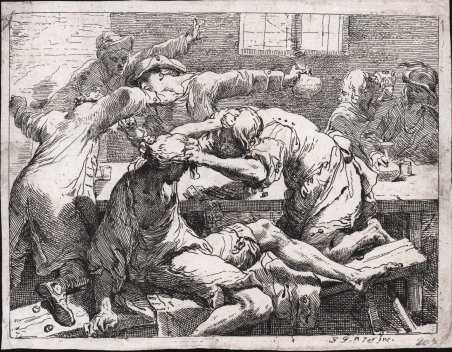Divertente e insolita composizione in cui, all’interno di una osteria un lungo tavolo di legno occupa lo spazio per tutta la sua larghezza, bicchieri e brocche di vino, l’osservatore assiste ad una scena tumultuosa carica di pathos. Cinque uomini si stanno azzuffando; la panca sulla quale erano seduti si è appena rotta, c’è chi afferra un uomo per i capelli, chi è pronto a dare uno schiaffo e chi con una brocca in mano sta per colpire un uomo di spalle. Dal tavolo cadono carte da gioco e dadi, le pose e la plasticità dei corpi rendono vera la scena alla quale assistono due personaggi sulla destra. Acquaforte, circa 1770/80, firmata in lastra in basso a destra. Bellissima prova, ricca di toni, impressa su carta vergata coeva, con sottili margini, minimi restauri all’angolo inferiore sinistro e al lato destro, per il resto in ottimo stato di conservazione. Il pittore e incisore Gaetano Gandolfi cresce in una famiglia di artisti. Istruito dal fratello maggiore Ubaldo Gandolfi e da Ercole Lelli all'Accademia Clementina di Bologna, trascorse l'anno 1760 a Venezia, dove fu influenzato soprattutto dall'opera di Giambattista Tiepolo. Dopo il suo ritorno a Bologna, Gandolfi divenne uno dei più ricercati pittori di scene e affreschi del suo tempo. Gandolfi fu una figura importante ed eclettica della Bologna del XVIII secolo. Fu pittore e abilissimo disegnatore, ma si dedicò con successo anche all'incisione. Come concordano i suoi biografi, fin da giovane era solito definire progressivamente la giustezza della sua intuizione nel disegno. Decine e decine di schizzi e disegni di Gandolfi si trovano in musei e collezioni private di tutto il mondo. Fin dal XVIII secolo sono oggetto di collezionismo e rappresentano un modo sicuro per conoscere lo sviluppo del suo pensiero e l'evoluzione dello stile che influenzerà la scuola bolognese fino alla metà del secolo successivo. I suoi studi di testa, di composizione e anatomici a penna e inchiostro, a matita e a pastello erano molto apprezzati dai suoi contemporanei. La sua attività di insegnante all'Accademia di Bologna gli permise di esercitare un'influenza decisiva sul lavoro delle generazioni di artisti successive. Gandolfi produsse anche una vastissima opera a stampa, che comprendeva stampe riproduttive e stampe di sua invenzione. Bibliografia F. Gozzi, ' Ubaldo, Gaetano e Mauro Gandolfi: le incisioni, n. 10/2; De Vesme n. 15; Bertelà n. 309. The brawl in the tavern. Funny and unusual composition in which, inside a tavern a long wooden plate occupies the space for its full width, glasses and jugs of wine, the viewer witnesses a tumultuous scene charged with pathos. Five men are brawling; the bench on which they were seated has just broken, some grab a man by the hair, some are ready to slap him, and some with a jug in their hands are about to hit a man from behind. Playing cards and dice fall from the plate; the poses and plasticity of the bodies make real the scene witnessed by two characters on the right. Etching c.1770-80, signed with initials on plate. Beautiful proof, rich in tone, printed on contemporary laid paper, with thin margins, minimal restorations to lower left corner and right side, otherwise in excellent condition. Painter and engraver Gaetano Gandolfi grew up in a family of artists. Instructed by his older brother Ubaldo Gandolfi and Ercole Lelli at the Accademia Clementina in Bologna, he spent the year 1760 in Venice, where he was influenced mainly by the work of Giambattista Tiepolo. After his return to Bologna, Gandolfi became one of the most sought-after painters of scenes and frescoes of his time. Gandolfi was an important and eclectic figure in 18th-century Bologna. He was a painter and very skilled draughtsman, but he also devoted himself successfully to engraving. As his biographers agree, from a young age he used to progressively define the rightness of his intuition in drawing. Dozens and dozens of Gandolfi's sketches and drawings are found in museums and private collections around the world. Since the 18th century they have been collectibles and are a sure way to learn about the development of his thought and the evolution of the style that would influence the Bolognese school until the middle of the following century. His head, composition, and anatomical studies in pen and ink, pencil, and pastel were highly prized by his contemporaries. His work as a teacher at the Bologna Academy enabled him to exert a decisive influence on the work of later generations of artists. Gandolfi also produced a very large print oeuvre, which included reproductive prints and prints of his own invention. Bibliografia F. Gozzi, ' Ubaldo, Gaetano e Mauro Gandolfi: le incisioni, n. 10/2; De Vesme n. 15; Bertelà n. 309. Cfr.

Scopri come utilizzare
Scopri come utilizzare

